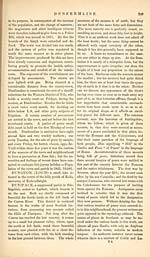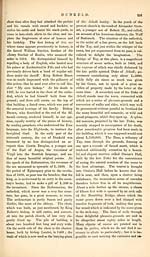Gazetteer of Scotland > Volume 1
(282) Page 250 - DUN
Download files
Complete book:
Individual page:
Thumbnail gallery: Grid view | List view

250
DUNKELD.
tin, though occasionally the Romans qualified
the harsh designations of the Celts by a sono-
rous termination. There are strong reasons
for supposing that these mounts are sepulchral
monuments. Human hones and arms have
been discovered in earthen fabrics of a similar
construction, in many parts of the island, and
the little mounts or barrows which are scat-
tered in great numbers around Stonehenge, in
Salisbury plain, are understood to be the sepul-
chres of the ancient Britons. Under this
impression, the name of Dunipace may be
traced to Duin-na-Bais, or the " Hills of
Death." Retaining this etymology as more
feasible than the other, and conceding that
they are not sepulchres, the name will be
equally appropriate to a spot where the judg-
ment of death, or other solemn judicial pro-
ceedings, used to take place. Be this as it may,
Dunipace is taken notice of in history, as a
place where important national causes have
been decided, and that more than once, by
great monarchs in person. Among the latest
occurrences of this kind, we find that, on the
140i of October 1301, Edward I. of England
here signed a warrant to his plenipotentiaries,
who were at that time in France, authorizing
them to consent to a truce with the Scots, as a
necessary preliminary towards a peace with their
ally, the French King, between whom and Ed-
ward an obstinate war had long raged.
DUNKELD AND DOWALLY, two
parishes in the centre of Perthshire, now unit-
ed into one, the capital of which is the town
of Dunkeld. The parish of Dunkeld consists
of no more land than that which is covered by
the houses of the town. To the N. W. along
the east bank of the Tay, is the parish of
Dowally, which constitutes what may be call-
ed the country part of Dunkeld parish. A por-
tion of Dowally is separated from the larger
part of the district by an intervening part of
the parish of Logierait. The land is of an
irregular romantic nature, devoted mostly to
pasture and to plantations. In the lower parts
there are some fine haughs. Craigie-Barns
and King's Seat are the chief hills. To the
east, among the high grounds, is Loch Ordie.
The town of Dunkeld is the chief and central
point in the tract of beautifully romantic
Ecenery, which constitutes the upper part of
Perthshire. It is situated fifty-seven miles
distant from Edinburgh, fifteen from Perth,
twenty-four from Kenmore, and twelve from
11.
Blairgowrie. In ascending the banks of the
Tay from Perth, Dunkeld is found nestling in
the bosom of an amphitheatre of hills, exactly
at the place where the Highlands and Low-
lands seem to meet, and where the noble river
first emerges from its mountain fastnesses, in-
to the fertile land to which it contributes so
much additional beauty. The first peep of the
town, as obtained from Birnam Hill, is exceed-
ingly striking. Deep under th<5 brows of the
lofty woody hills, lies the little Highland town,
rendered in itself worthy of the picturesque
scenery around and above it, by the fine antique
effect of its ruined cathedral, rising above even
the lofty trees that encompass it, and the
modern elegance of the bridge over the Tay,
by which the village is approached. Dunkeld
is chiefly interesting as the object of a pleasure
tour, or as a point in Highland scenery from
which radiate many various lines of route.
Being thus a place of infinite resort in summer,
it is provided with two inns, one of which is
upon a first rate scale, both as to extent and
quality of accommodation, containing, in 1826,
no fewer than thirty-five bedrooms. The
houses of the town are in general old, and of
humble appearance; and no manufacture worth
notice seems to have as yet found its way into
this retired spot, except the preparing of lea-
ther. The origin of the place as a settlement
of population is lost in the mists of antiquity.
The Gaelic name of the place, Dunchailledun,
seems, to our perceptions, to indicate a fort on
the top of some one of the neighbouring woody
hills ; but the earliest authentic notice speaks
of nothing but a retreat of the early religious
order, called the Culdees. This ancient mo-
nastery, which authentic history notices so early
as 729, was, in 1 127, converted into the seat
of a bishopric, by David I. on the country
passing from the Culdee to the Roman Catho-
lic establishment. How a religious institution
of this order could exist in such a spot, at such
a time, is to us matter of astonishment. We
find, in Spottiswood's Church History, that
the poor bishops had dreadful battles to fight
occasionally, with the lawless clans around
them. The clan Donnachy, or Robertson,
seems to have been a dreadful source of annoy-
ance to the holy men. It is, at the same time,
amusing to find, that the terrors of the church
would sometimes assert their sway over the
superstitious and half-instructed minds of the
savare chiefs, compelling them, perhaps only a
DUNKELD.
tin, though occasionally the Romans qualified
the harsh designations of the Celts by a sono-
rous termination. There are strong reasons
for supposing that these mounts are sepulchral
monuments. Human hones and arms have
been discovered in earthen fabrics of a similar
construction, in many parts of the island, and
the little mounts or barrows which are scat-
tered in great numbers around Stonehenge, in
Salisbury plain, are understood to be the sepul-
chres of the ancient Britons. Under this
impression, the name of Dunipace may be
traced to Duin-na-Bais, or the " Hills of
Death." Retaining this etymology as more
feasible than the other, and conceding that
they are not sepulchres, the name will be
equally appropriate to a spot where the judg-
ment of death, or other solemn judicial pro-
ceedings, used to take place. Be this as it may,
Dunipace is taken notice of in history, as a
place where important national causes have
been decided, and that more than once, by
great monarchs in person. Among the latest
occurrences of this kind, we find that, on the
140i of October 1301, Edward I. of England
here signed a warrant to his plenipotentiaries,
who were at that time in France, authorizing
them to consent to a truce with the Scots, as a
necessary preliminary towards a peace with their
ally, the French King, between whom and Ed-
ward an obstinate war had long raged.
DUNKELD AND DOWALLY, two
parishes in the centre of Perthshire, now unit-
ed into one, the capital of which is the town
of Dunkeld. The parish of Dunkeld consists
of no more land than that which is covered by
the houses of the town. To the N. W. along
the east bank of the Tay, is the parish of
Dowally, which constitutes what may be call-
ed the country part of Dunkeld parish. A por-
tion of Dowally is separated from the larger
part of the district by an intervening part of
the parish of Logierait. The land is of an
irregular romantic nature, devoted mostly to
pasture and to plantations. In the lower parts
there are some fine haughs. Craigie-Barns
and King's Seat are the chief hills. To the
east, among the high grounds, is Loch Ordie.
The town of Dunkeld is the chief and central
point in the tract of beautifully romantic
Ecenery, which constitutes the upper part of
Perthshire. It is situated fifty-seven miles
distant from Edinburgh, fifteen from Perth,
twenty-four from Kenmore, and twelve from
11.
Blairgowrie. In ascending the banks of the
Tay from Perth, Dunkeld is found nestling in
the bosom of an amphitheatre of hills, exactly
at the place where the Highlands and Low-
lands seem to meet, and where the noble river
first emerges from its mountain fastnesses, in-
to the fertile land to which it contributes so
much additional beauty. The first peep of the
town, as obtained from Birnam Hill, is exceed-
ingly striking. Deep under th<5 brows of the
lofty woody hills, lies the little Highland town,
rendered in itself worthy of the picturesque
scenery around and above it, by the fine antique
effect of its ruined cathedral, rising above even
the lofty trees that encompass it, and the
modern elegance of the bridge over the Tay,
by which the village is approached. Dunkeld
is chiefly interesting as the object of a pleasure
tour, or as a point in Highland scenery from
which radiate many various lines of route.
Being thus a place of infinite resort in summer,
it is provided with two inns, one of which is
upon a first rate scale, both as to extent and
quality of accommodation, containing, in 1826,
no fewer than thirty-five bedrooms. The
houses of the town are in general old, and of
humble appearance; and no manufacture worth
notice seems to have as yet found its way into
this retired spot, except the preparing of lea-
ther. The origin of the place as a settlement
of population is lost in the mists of antiquity.
The Gaelic name of the place, Dunchailledun,
seems, to our perceptions, to indicate a fort on
the top of some one of the neighbouring woody
hills ; but the earliest authentic notice speaks
of nothing but a retreat of the early religious
order, called the Culdees. This ancient mo-
nastery, which authentic history notices so early
as 729, was, in 1 127, converted into the seat
of a bishopric, by David I. on the country
passing from the Culdee to the Roman Catho-
lic establishment. How a religious institution
of this order could exist in such a spot, at such
a time, is to us matter of astonishment. We
find, in Spottiswood's Church History, that
the poor bishops had dreadful battles to fight
occasionally, with the lawless clans around
them. The clan Donnachy, or Robertson,
seems to have been a dreadful source of annoy-
ance to the holy men. It is, at the same time,
amusing to find, that the terrors of the church
would sometimes assert their sway over the
superstitious and half-instructed minds of the
savare chiefs, compelling them, perhaps only a
Set display mode to: Large image | Transcription
Images and transcriptions on this page, including medium image downloads, may be used under the Creative Commons Attribution 4.0 International Licence unless otherwise stated. ![]()
| Gazetteers of Scotland, 1803-1901 > Gazetteer of Scotland > Volume 1 > (282) Page 250 - DUN |
|---|
| Permanent URL | https://digital.nls.uk/97427746 |
|---|
| Description | Volume I: Abbey to Glenartney. |
|---|---|
| Attribution and copyright: |
|
| Description | By Robert Chambers and William Chambers. Glasgow: Blackie & Son, 1838. 2 volumes. |
|---|---|
| Shelfmark | NF.1461.g.7 |
| Additional NLS resources: | |

